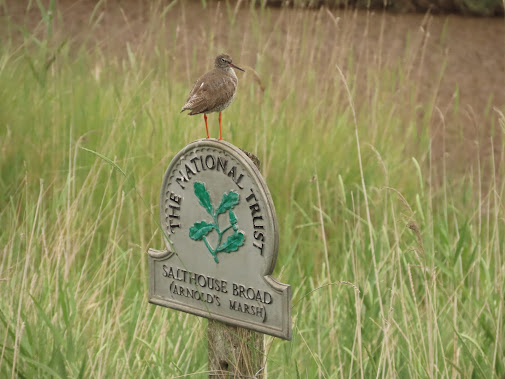Having visited the BEE EATERS at Trimingham near Cromer in the morning I had time to visit Cley Marshes nearby. Being Cley and the start of Autumn, migrating waders were the order of the day, birds that are much easier to find on the lazy return migration than in the rush of Spring.
Its a strange quirk in nature that the Autumn season begins in mid June, a time of high summer, but this is the time when WADERS start to return from their breeding grounds. There are different reasons for different species arriving back so early, for the RUFFS, the male has no part in raising chicks, or maybe for the SPOTTED REDSHANKS, they are mainly failed breeders. At this time of year the birds look resplendent in their breeding plumage, as for a few months over the summer these birds bedeck themselves in ostentatious plumages, in stark contrast to the greys and browns of winter. The birds were mainly located on the freshwaters scrapes, Simmonds Scrape and Pat's Pool in the centre of the reserve, and the brackish Arnold's Marsh. located just behind the shingle bank, from East Wall.
Perhaps the most flamboyant of waders is the RUFF, of which there were three on Pat's Pool. At this time of year the birds are males, and the birds are bedecked like the ruffs of Elizabethan nobles (which I am sure is how they got their name). Each male is unique and today one was outfitted with a natty black and white neck plumage. There was a SPOTTED REDSHANK as well, also on Pat's Pool, which at this time of year looks so unlike a common redshank, its nearest relative, its unbelievable. The bird was plumaged in jet black with white spots which give it its name. A GOLDEN PLOVER on Simmond's Scrape was black chested with a gold back, with three more on Arnold's Marsh. Brick red BLACK TAILED GODWITS were on the Serpentine near Arnold's Marsh with a GREENHANK. Slightly more dowdy, being a darkish brown and white was a GREEN SANDPIPER on Pat's Pool, and two CURLEW were on Arnold's Marsh. This was quite a good haul for the fluttering start of Autumn, but gradually the number of migrating waders will build up until it reaches its peak in late August and early September.
REDSHANK are pleasantly common at Cley, the rough grazed fields which make up a large chunk of the reserve provides plenty of home for them to nest in. Many chicks of various ages could be seen feeding round the edges of the various pools, and there would have been many more hidden in the grass. The adults, of course were very noticeable, and although they are only brown in plumage, they have the most haunting of calls, which really provides atmosphere to these marshes. A few very late LAPWING young were about and a small number of nearly fledged AVOCET young were on the various pools. There were also OYSTERCATCHERS and RINGED PLOVERS on the various pools and shingle stacks on the reserve.
Being North Norfolk SPOONBILLS were plentiful, with one resident on Pat's Pool, while at least five flew over. They can be easily separated from the similar sized LITTLE EGRET in flight, by the fact the spoonbill flies with its neck out-stretched, while the egret tucks its neck in like a heron. Apparently the spoonbills have successfully nested in land just off the reserve, I think in an area of trees near the start of East Wall. With so much destruction going on with our wildlife, its just so heartening to hear of a bird that has actually recolonised our country and increased.
GULLS and TERNS don't really nest at Cley, but they do in other places across the North Norfolk coast, but there was still a decent selection on show here today. Five LITTLE GULLS were on Arnold's Marsh, with a flock of 70 non-breeding SANDWICH TERNS also there. A flotilla of five LITTLE TERNS flew in from the sea and flew east along just behind the shingle stack, its always a delight to see this delicate bird.
DUCKS were relatively absent from Cley with various broods of SHELDUCK of different ages the only breeding record. Some TEAL had returned to spend the Autumn and eventually the winter here and a WIGEON was on the North Scrape, but that was it really.
The summer months are a time of intense energy for our smaller birds, for whom its still the nesting season. The Birds are busy raising families in the bountiful landscape that make up the Marshes. In the various hides that look over the scrapes SWALLOWS were nesting within, flying in and out of the open slats, returning to nests high above your head right as you watched the birds outside. BEARDED TITS could be heard in the extensive reedbeds, their metallic "pinging" call could be heard in snatches as the birds would fly between reed stems providing brief glances. REED WARBLERS were very plentiful, seen allover the reserve, this plain brown bird could be seen going to and fro from their nest embedded deep within the reeds.
As usual it was an excellent couple of hours spent birding the splendiferous birdwatching mecca of Cley Marshes. Its so good just to check into these places to see what's happening in this neck of the woods. North Norfolk is such a great location just to visit really, at any time of year there is always something of interest to see. For mid June what I saw was better than expected, although the birds recorded were typical of early Autumn waders, you don't often get to see them all at once in the same place.









No comments:
Post a Comment